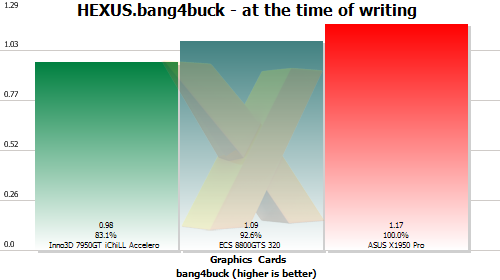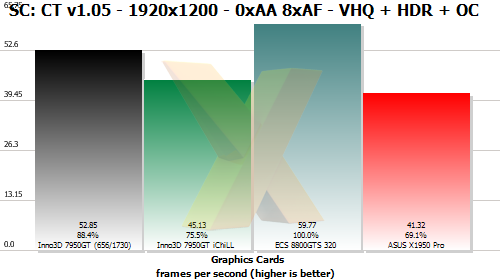HEXUS.bang4buck and overclocking
HEXUS.bang4buck
In a rough-and-ready assessment of the card's bang per buck, we've aggregated the average 1920x1200 4xAA 8xAF framerates for the three games, normalised them*, and listed the cards' price. There are more provisos than I care to shake a stick at. We could have chosen three different games, the cards' prices could have been derived from other sources and pricing is such that it can fluctuate daily. However, to reiterate, the graph below highlights a metric that should only be used as a yardstick for evaluating comparative performance with price factored in. Other architectural benefits are not covered, obviously.| Graphics card(s) | Inno3D GeForce 7950GT Accelero S1M 256MiB (560/1500) | ECS N8800GTS-320MX 320MiB (513/1600) | ASUS EAX1950Pro 256MiB (580.5/1404) |
|---|---|---|---|
| Actual aggregate marks at 1920x1200 4xAA 8x(16x)AF | 171.18 | 221.12 | 149.8 |
| Aggregate marks, normalised*, at 1920x1200 | 151.22 | 195.63 | 134.7 |
| Price - at time of writing | £155 | £180 | £115 |
| HEXUS.bang4buck score | 0.976 | 1.087 | 1.171 |
| Acceptable framerate (60FPS av.) at 1920x1200 4xAA 8xAF | No | No | No |
* - The normalisation refers to taking playable framerate into account. Should a card benchmark at over 60FPS in any one game, the extra FPS counts as half. Similarly, should a card benchmark lower, say at 40FPS, we deduct half the difference from its average framerate and the desired 60FPS, giving it a bang4buck score of 30 marks. The minimum framerate, then, can be 20FPS, as that will score 0.
As an example, should a card score 120FPS we count it as 90FPS (120 - (120-60)/2) as only half the framerate above 60FPS is counted for the bang4buck. Similarly, should it score 30FPS we count it as only 15FPS (30 + (30-60)/2).
The reasoning behind such calculation lies with playable framerates. Should card A score 110FPS in a benchmark and card B 160, then card B would normally receive an extra 50 marks in our bang4buck assessment, even though both cards produce perfectly playable framerates and anything above 60FPS is a bonus and not a necessity for most. However, the bang4buck total would be identical if in another benchmark card A scored a smooth 70FPS and card B an unplayable 20FPS, as both aggregate to 180 marks, yet the games-playing experience would be vastly different. You would, on balance, say that card A was better because it ran smoothly in both games. In our revised aggregation, card A would receive 150 marks (85 + 65) and card B 100 (100 + 0).
In effect, we're including a desired average framerate, in this case 60, and penalising lower performance whilst giving higher-than 60FPS framerates half as much credit as the framerate up to 60FPS. If that doesn't make sense or you have issue with it, please hit the HEXUS community.

Dividing the normalised marks by the price to deliver an easy-to-understand value metric, we see that spending a little extra buys you exponentially better performance, whilst spending less (X1950 Pro) does result in lower performance in our trio of games, but by a smaller percentage than the drop in price. Of course, enhancements such as zero-noise cooling aren't taken into account, and that would be the main reason for considering this SKU in the first instance.
Overclocking
We managed to increase the card's clocks from the shipping 560/1500 to an altogether impressive 656/1730, lending further weight to the qualities of the Accelero S1M cooler. We then re-ran Splinter Cell: Chaos Theory at 1920x1200 0xAA 8xAF + HDR, to see how much of an additional boost the overclocked speeds gave.
The answer is around a 17 per cent increase in average framerates, making the game a little less stuttery in action-packed scenes.









